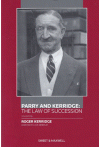- Publisher: Thomson Sweet & Maxwell
- Edition: 13 Ed South Asian Edition 2019
- ISBN 13 9789389407228
- Approx. Pages 666 + Contents
- Format Paperback
- Approx. Product Size 24 x 16 cms
- Delivery Time 3-5 working days (within Kerala & South India) (Others 7-9 days)
- Shipping Charge Extra (see Shopping Cart)
...................................................................................................................................................................................................................................
Description
Parry and Kerridge: The Law of Succession has been the leading textbook on the law of succession for over 70 years, providing the detail required for a full understanding of the subject. The work covers not only wills and intestacy, but also probate and the administration of estates. The 13th edition has been thoroughly updated and incorporates all key legislative developments including those brought about by the Inheritance and Trustees' Powers Act 2014, amending both the law of intestacy and family provision. Case law developments have been significant both in content and number and include Marley v Rawlings, rectification of a switched will; Thorner v Major, Henry v Henry, Bradbury v Taylor and Suggitt v Suggitt, proprietary estoppel; Barrett v Bern, attestation; Baynes v Hedger, family provision, living together as civil partners; llott v Mitson, family provision for an estranged adult daughter; Re Key and Simon v Byford, capacity; Re P, statutory wills and "best interests" under the Mental Capacity Act 2005; Perrins v Holland, the rule in Parker v Felgate; Cill v Woodall, knowledge and approval; Re Servoz-Cavin, a sailor's oral will; Court v Despallieres, revocation of a will by formation of a civil partnership; Rawstron v Freud, secret trusts; Fry v Densham-Smith, mutual wills; King v Chiltern Dog Rescue, donationes mortis causa; Day v Royal College of Music, the rule in Strong v Bird; Re Erskine, the effect of the Human Rights Act 1998 on construction. Roger Kerridge and A.H.R. Brierley bring to this edition
considerable experience of the teaching and practice of the law of
succession. Parry and Kerridge: The Law of Succession can be recommended
to all teachers, students and practitioners of succession as a
reliable, comprehensive, authoritative and clearly written guide to
thiscomplex area of law.
.....................................................................................................................................................................................................................................
Contents
1. Introduction — The Transfer of Property on Death
2. Intestacy
3. The Nature of Wills
4. Formalities
5. The Making of Wills: Capacity—The Mind of the Testator
6. Promises to Leave Property by Will; Secret Trusts; Mutual Wills; Donationes Mortis Causa;
The Rule in Strong v Bord
7. Revocation, Alternation, Revival and Confirmation of Wills
8. Provision for the Deceased's Family and Dependants
9. The Contents of a Will
10. The Rectification and Construction Powers of Appointment
11. The Construction of Wills: Specific Rules of Construction : The Construction of Powers
12. The Date from which a Will Speaks
13. Satisfaction
14. Failure of Gift by Will or of Interest on Intestacy
15. Duty of Care
16. Tax
17. Executors and Administrators
18. Grants of probate and Letters of Administration
19. The Making and Revocation of Grants
20. Collection Realisation and Management of the Estate
21. Payment of Expenses and Debts and Incidence of General Legacies
22. Income and Interest
23. Distribution of the Estate
24. Remedies
Index
............................................................................................................................................................................................................................
Author Details
Rogr Kerridge Emeritus Professor of Law; University of Bristol Solicitor
............................................................................................................................................................................................................................

